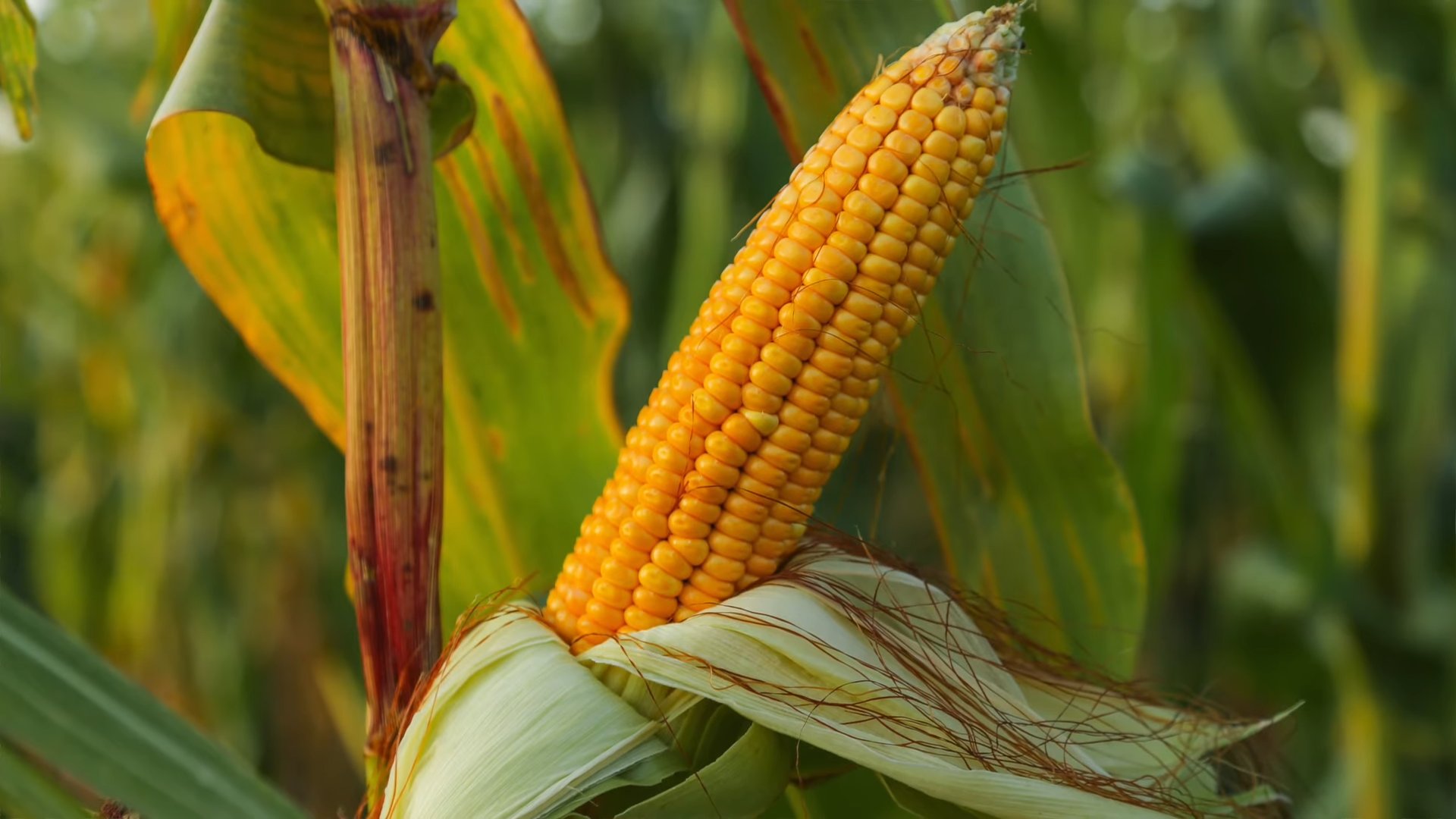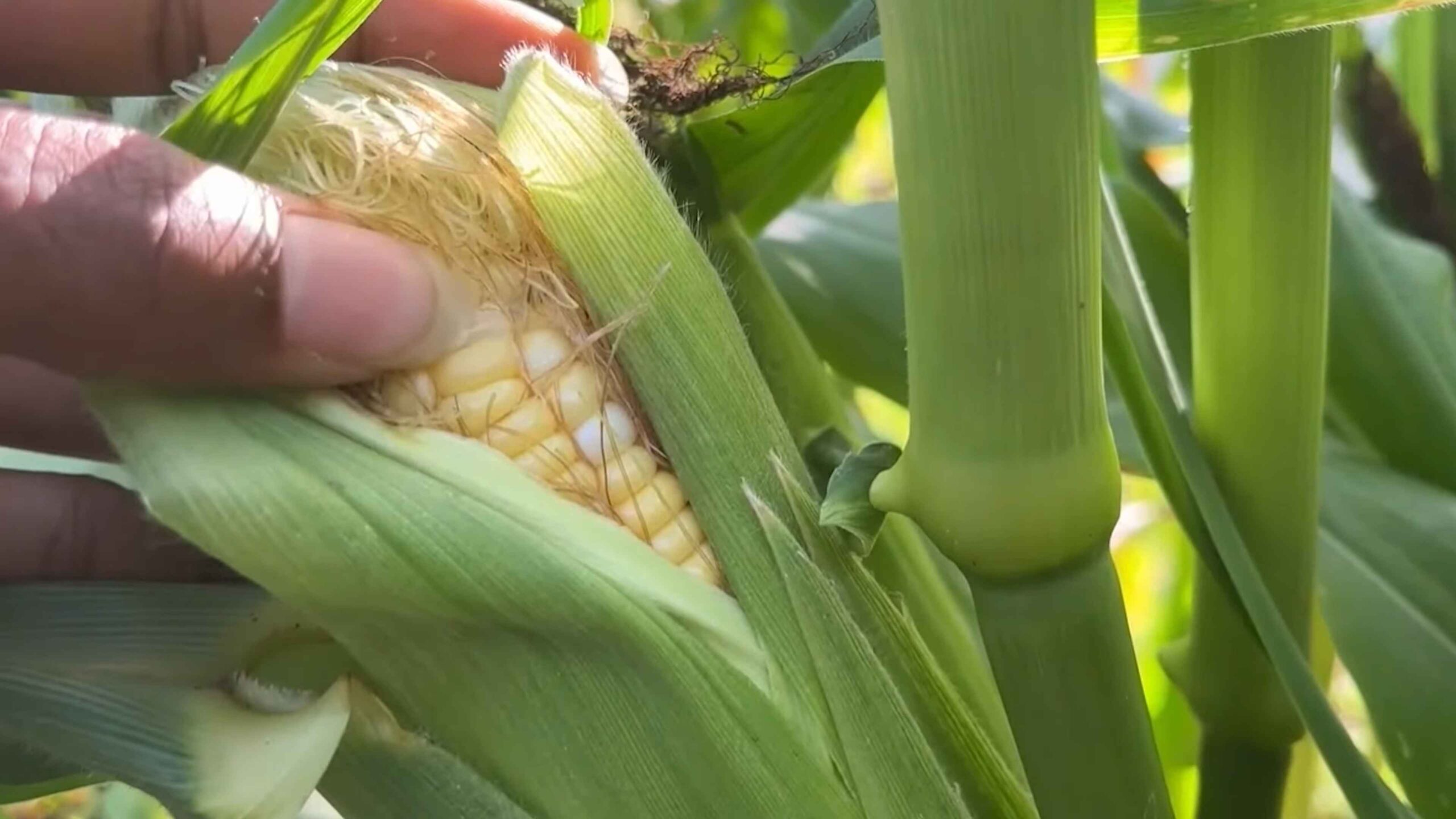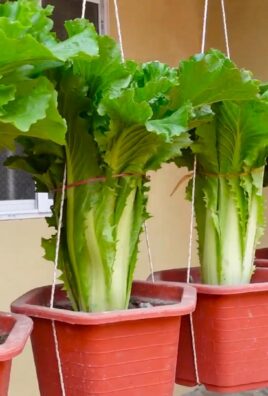Grow Sweet Corn Backyard – sounds like a dream, right? Imagine stepping outside your back door and harvesting juicy, sweet corn, fresh from your own garden. It’s not just a dream; it’s an achievable reality with a little know-how! For centuries, corn has been a staple crop, deeply woven into the cultures of the Americas. From ancient civilizations to modern-day barbecues, corn has nourished and delighted us.
But let’s face it, the supermarket corn just doesn’t compare to the taste of homegrown. That’s where this DIY guide comes in. I’m going to share some simple yet effective tricks and hacks to help you successfully grow sweet corn backyard, even if you’re a beginner gardener.
Why do you need these tricks? Because growing corn isn’t always as straightforward as planting a seed and waiting. It needs specific conditions and care to thrive. This article will equip you with the knowledge to overcome common challenges, maximize your yield, and enjoy the unparalleled satisfaction of biting into your own freshly grown sweet corn. Get ready to transform your backyard into a cornucopia of deliciousness!

Growing Sweet Corn in Your Backyard: A Comprehensive DIY Guide
Hey there, fellow garden enthusiasts! I’m so excited to share my tried-and-true method for growing delicious sweet corn right in your own backyard. Forget those bland, grocery store ears – nothing beats the taste of freshly picked, homegrown corn. It’s easier than you might think, and I’m going to walk you through every step of the process. Let’s get started!
Choosing the Right Sweet Corn Variety
Before we even think about planting, we need to pick the perfect sweet corn variety for your garden. There are tons of options out there, each with its own unique characteristics. Here’s what I consider when making my selection:
- Days to Maturity: This is crucial! Check your local growing season and choose a variety that will mature before the first frost. Shorter season varieties are great for cooler climates.
- Sweetness: Sweet corn varieties are classified as standard, sugary enhanced (se), or supersweet (sh2). Supersweet varieties stay sweet longer after harvest, but they need to be isolated from other corn types to prevent cross-pollination. I personally love the sugary enhanced varieties for their balance of sweetness and classic corn flavor.
- Disease Resistance: Look for varieties that are resistant to common corn diseases in your area. This will save you a lot of headaches down the road.
- Kernel Color: Yellow, white, or bicolor? It’s all a matter of personal preference!
Some of my personal favorites include ‘Honey Select’ (supersweet, yellow), ‘Silver Queen’ (standard, white), and ‘Peaches and Cream’ (bicolor, sugary enhanced). Do some research and find what works best for you!
Preparing Your Garden Bed
Corn is a heavy feeder, meaning it needs a lot of nutrients to thrive. Proper soil preparation is key to a successful harvest.
- Sunlight: Sweet corn needs at least 6-8 hours of direct sunlight per day. Choose a location in your yard that gets plenty of sun.
- Soil: Corn prefers well-drained, fertile soil with a pH between 6.0 and 6.8. If your soil is heavy clay or sandy, you’ll need to amend it.
- Amendments: I always add plenty of compost to my garden bed before planting. Compost improves soil structure, drainage, and fertility. You can also add other organic amendments like well-rotted manure or leaf mold.
Step-by-Step Soil Preparation:
1. Clear the Area: Remove any weeds, grass, rocks, or debris from the planting area.
2. Till or Dig: Loosen the soil to a depth of at least 12 inches. You can use a tiller for larger areas or a garden fork for smaller plots.
3. Add Amendments: Spread a 2-3 inch layer of compost over the soil surface. Add any other desired amendments, such as manure or fertilizer.
4. Incorporate: Mix the amendments into the soil thoroughly using a tiller or garden fork.
5. Rake Smooth: Rake the soil surface smooth and level.
Planting Your Sweet Corn
Now for the fun part – planting! Corn is typically planted directly in the garden after the last frost.
- Timing: Wait until the soil temperature reaches at least 60°F (15°C) before planting. This usually occurs a week or two after the last frost.
- Spacing: Plant corn seeds 1-2 inches deep and 6-12 inches apart in rows. Space the rows 2-3 feet apart.
- Planting Pattern: Plant corn in blocks rather than long, single rows. This helps with pollination, as corn is wind-pollinated. A block of at least 4 rows is ideal.
Step-by-Step Planting Instructions:
1. Create Furrows: Use a hoe or trowel to create furrows in the prepared soil, spaced 2-3 feet apart.
2. Sow Seeds: Drop corn seeds into the furrows, spacing them 6-12 inches apart.
3. Cover Seeds: Cover the seeds with 1-2 inches of soil.
4. Water Gently: Water the planted area gently to moisten the soil. Avoid overwatering, which can cause the seeds to rot.
5. Mark Rows: Label the rows with the variety of corn you planted. This will help you keep track of your different varieties.
Caring for Your Sweet Corn
Once your corn is planted, it’s important to provide it with the care it needs to thrive.
- Watering: Corn needs consistent moisture, especially during tasseling and silking. Water deeply whenever the top inch of soil feels dry. Aim for about 1 inch of water per week.
- Fertilizing: Corn is a heavy feeder, so it needs regular fertilization. Side-dress your corn plants with a nitrogen-rich fertilizer when they are about 1 foot tall and again when they begin to tassel.
- Weeding: Keep the garden bed free of weeds, which can compete with your corn for nutrients and water. Hand-pull weeds regularly or use a hoe to cultivate the soil.
- Pest Control: Corn is susceptible to several pests, including corn earworms, aphids, and Japanese beetles. Monitor your plants regularly for signs of infestation and take action as needed. I prefer using organic pest control methods, such as insecticidal soap or neem oil.
Detailed Care Tips:
1. Watering Schedule: Water deeply and less frequently, rather than shallowly and often. This encourages deep root growth, which makes the plants more drought-tolerant. I usually water early in the morning to minimize evaporation.
2. Fertilizer Application: When side-dressing with fertilizer, sprinkle the fertilizer along the rows, a few inches away from the base of the plants. Gently work the fertilizer into the soil and water thoroughly.
3. Weed Prevention: Mulching around your corn plants can help suppress weed growth and conserve moisture. Use organic mulches like straw, wood chips, or shredded leaves.
4. Pest Monitoring: Check your corn plants regularly for signs of pests. Look for holes in the leaves, sticky residue, or visible insects. The earlier you catch a pest problem, the easier it will be to control.
5. Corn Earworm Control: Corn earworms are a common pest that can damage the ears of corn. To control corn earworms, you can apply mineral oil to the silks of the developing ears. Apply a few drops of mineral oil to the silks a few days after they emerge.
Pollination: Ensuring a Full Harvest
Corn is wind-pollinated, meaning that pollen from the tassels (the male flowers at the top of the plant) needs to land on the silks (the female flowers on the ears) for fertilization to occur. Poor pollination can result in ears with missing kernels.
- Planting Density: Planting corn in blocks rather than single rows helps to ensure good pollination.
- Wind Protection: Avoid planting corn in areas that are heavily sheltered from the wind.
- Hand Pollination (If Necessary): If you notice poor pollination, you can hand-pollinate your corn plants. Gently shake the tassels over the silks to release pollen. You can also collect pollen from the tassels and apply it directly to the silks using a small brush.
Hand-Pollination Technique:
1. Collect Pollen: In the morning, when the tassels are shedding pollen, gently shake a tassel over a clean container to collect the pollen.
2. Apply Pollen: Use a small brush to apply the collected pollen to the silks of the developing ears.
3. Repeat: Repeat the process for several days to ensure that all of the silks are pollinated.
Harvesting Your Sweet Corn
The moment we’ve all been waiting for – harvesting! Knowing when to harvest sweet corn is crucial for getting the best flavor and texture.
- Timing: Sweet corn is typically ready to harvest about 20-25 days after the silks emerge.
- Silk Color: The silks should be dry and brown.
- Ear Feel: The ear should feel plump and full.
- Kernel Test: Gently peel back the husk and puncture a kernel with your fingernail. The liquid inside should be milky. If it’s clear, the corn is not ripe. If it’s doughy, the corn is overripe.
Step-by-Step Harvesting Instructions:
1. Grasp the Ear: Grasp the ear firmly with one hand.
2. Pull Downward: Pull the ear downward and twist it slightly to snap it off the stalk.
3. Enjoy Immediately: Sweet corn

Conclusion
So, there you have it! Growing sweet corn in your backyard isn’t just a whimsical dream; it’s an achievable reality with a little planning and effort. We’ve walked you through the essential steps, from selecting the right varieties and preparing your soil to warding off pests and harvesting your golden bounty. But why should you even bother with this endeavor? Why not just grab a few ears from the grocery store?
The answer lies in the unparalleled flavor and freshness you simply can’t replicate with store-bought corn. Imagine sinking your teeth into a perfectly ripe ear, bursting with sweet, milky juice, picked just moments before. That’s the magic of homegrown sweet corn. Plus, there’s an immense satisfaction that comes from nurturing a plant from seed to table, knowing you’ve created something delicious and wholesome with your own hands.
This DIY approach to growing sweet corn offers a level of control and customization you won’t find anywhere else. You can choose organic methods, avoiding harmful pesticides and herbicides. You can experiment with different varieties, discovering your personal favorites. And you can tailor your growing practices to suit your specific climate and soil conditions.
This isn’t just about growing corn; it’s about connecting with nature, learning new skills, and enjoying the fruits (or vegetables!) of your labor.
Feeling adventurous? Consider these variations to spice things up:
* **Succession Planting:** Plant new rows of sweet corn every two weeks to extend your harvest season. This ensures a continuous supply of fresh corn throughout the summer.
* **Companion Planting:** Plant beans or peas near your corn to help fix nitrogen in the soil, naturally fertilizing your crop. Sunflowers can also provide shade and support.
* **Heirloom Varieties:** Explore heirloom sweet corn varieties like ‘Golden Bantam’ or ‘Country Gentleman’ for unique flavors and textures.
* **Container Gardening:** If you’re short on space, try growing dwarf sweet corn varieties in large containers. Just make sure they get plenty of sunlight and water.
Ultimately, the best way to learn is by doing. Don’t be afraid to experiment, make mistakes, and learn from your experiences. Growing sweet corn in your backyard is a journey, not just a destination.
We wholeheartedly encourage you to give this DIY trick a try. It’s a rewarding experience that will not only fill your plate with delicious corn but also enrich your life in countless other ways. Once you’ve harvested your first crop, we’d love to hear about your experience! Share your tips, tricks, and triumphs in the comments below. Let’s build a community of backyard sweet corn growers and inspire others to embrace the joy of homegrown goodness. Happy growing!
Frequently Asked Questions (FAQ)
What is the best time to plant sweet corn?
The ideal time to plant sweet corn is after the last expected frost in your area, when the soil temperature has reached at least 60°F (15°C). Sweet corn is a warm-season crop and requires consistent warmth to germinate and grow properly. Planting too early can lead to poor germination and stunted growth. Check your local weather forecasts and soil temperature before planting. A soil thermometer is a handy tool for this. Generally, late spring to early summer is the sweet spot for most regions.
How much space does sweet corn need?
Sweet corn needs adequate space to thrive. Plant seeds about 1-2 inches deep and 6-12 inches apart within rows. Rows should be spaced 30-36 inches apart. This spacing allows for proper air circulation, sunlight penetration, and root development. Remember that sweet corn is wind-pollinated, so planting in blocks rather than long, single rows is crucial for successful pollination. A minimum block size of 4 rows by 4 plants is recommended.
What kind of soil is best for growing sweet corn?
Sweet corn prefers well-drained, fertile soil with a pH between 6.0 and 6.8. Amend your soil with compost or other organic matter to improve drainage, fertility, and water retention. A soil test can help you determine the pH and nutrient levels of your soil, allowing you to make necessary adjustments. Avoid heavy clay soils, as they can become waterlogged and hinder root growth. If you have clay soil, consider adding sand and organic matter to improve its structure.
How often should I water sweet corn?
Sweet corn needs consistent moisture, especially during germination and ear development. Water deeply and regularly, aiming for about 1 inch of water per week. Avoid overhead watering, as it can promote fungal diseases. Drip irrigation or soaker hoses are excellent options for delivering water directly to the roots. Check the soil moisture regularly and adjust your watering schedule accordingly, especially during hot, dry periods.
How do I know when sweet corn is ready to harvest?
Several indicators can help you determine when your sweet corn is ready to harvest. The silks should be brown and dry, but still slightly moist. The ears should feel plump and full, and the kernels should be milky when punctured with your fingernail. The husks should be tight and green. A good rule of thumb is to harvest about 20 days after the silks first appear. Don’t wait too long to harvest, as the kernels can become starchy and less sweet.
What are some common pests and diseases that affect sweet corn?
Common pests that affect sweet corn include corn earworms, European corn borers, and aphids. Diseases include corn smut, rust, and leaf blight. Implement preventative measures such as crop rotation, companion planting, and using resistant varieties. Regularly inspect your plants for signs of pests or diseases and take appropriate action, such as hand-picking pests, using insecticidal soap, or applying fungicides. Encourage beneficial insects like ladybugs and lacewings to help control pest populations.
Can I grow sweet corn in containers?
Yes, you can grow sweet corn in containers, but it requires some extra attention. Choose dwarf or compact varieties that are specifically bred for container gardening. Use large containers (at least 15 gallons) with good drainage. Provide plenty of sunlight (at least 6-8 hours per day) and water regularly. Fertilize frequently with a balanced fertilizer. Remember that container-grown corn may not produce as many ears as corn grown in the ground.
How can I improve pollination in my sweet corn patch?
Sweet corn is wind-pollinated, so ensuring good pollination is crucial for a successful harvest. Plant your corn in blocks rather than long, single rows to increase the chances of pollen reaching the silks. On calm days, you can gently shake the stalks to release pollen. You can also hand-pollinate by collecting pollen from the tassels and applying it to the silks. Avoid using pesticides that can harm pollinators.
How do I store sweet corn after harvesting?
Sweet corn is best enjoyed fresh, but you can store it for a few days in the refrigerator. Leave the husks on and wrap the ears in a plastic bag. For longer storage, you can freeze or can your sweet corn. To freeze, blanch the ears for a few minutes, then cool them in ice water before freezing. To can, follow a tested canning recipe to ensure food safety.
What are some good companion plants for sweet corn?
Good companion plants for sweet corn include beans, peas, squash, cucumbers, and sunflowers. Beans and peas help fix nitrogen in the soil, naturally fertilizing the corn. Squash and cucumbers provide ground cover, suppressing weeds and conserving moisture. Sunflowers can provide shade and support for the corn stalks. Avoid planting tomatoes or brassicas (cabbage, broccoli, cauliflower) near sweet corn, as they can compete for nutrients or attract pests.





Leave a Comment